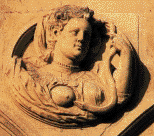|
|
A BRIEF HISTORY OF SALAMANCA
Salamanca, throughout its long history, has been a protagonist of Spain's most significant historical events. PreRoman remains can be found in Teso de San Vicente, beside the river Tormes, in the verraco (Iberian statue representing a bull) situated in the centre of the Roman bridge, in the city walls, in numerous inscriptions and along the Calzada de la Plata which, passing through Salamanca, united Merida and Astorga. Salmántica belonged to the Roman province of Lusitania, was besieged by Hannibal and we have little information of the Visigothic era.
Conquered by the Arabs, lost and recuperated several times by the Christians, it was definitively reconquered by the great pro-European king Alfonso VI.
In 1200 Alfonso IX founded what was to become the University of Salamanca eighteen years later. Salamanca thus owes its renown and prosperity to this king. The new University soon received great favours from Fernando el Santo and Alfonso X el Sabio who established the number and type of chairs the University was to be composed of. In 12 54, Pope Alexander IV called the University of Salamanca "one of the four leading lights of the world".
|
|
|
MORE HISTORY...
The city took part in the War of Succession, on the side of Felipe V. Conquered by the Archduke's troops, it was soon recovered by the founder of the Bourbon dynasty, who stayed here for several days in 1710, when the construction of the Plaza Mayor (Main Square) was decided on.
Salamanca was badly affected by the Peninsular War. From 1808 to 1811 it was open to the armies who disputed the hegemony of Europe on Spanish soil. At last, the battle of Arapiles, at the very gates of the city and in which Wellington defeated Napoleon's army, led to the withdrawl of the latter from Spanish territory. But this withdrawl left behind the destruction of marvellous architectural treasures, many colleges, palaces and buildings such as the Colegio Mayor de Cuenca which was considered to be "one of the marvels of architecture".

|
|
Palacio de La Salina
|
In the field of Art, all the styles have left their most worthy and exquisite mark on this city. The Spanish Plateresque style, of decorative quality and fine execution, offers its most beautiful examples here in Salamanca. This decorative tendency of the Plateresque style finds its possibilities accentuated when carried out on a soft stone of a beautiful golden colour.
CELEBRITIES
Innumerable historical celebrities, from Fray Luis de Leon, Antonio de Nebrija, Francisco de Vitoria, Cervantes, Menendez Valdes, San Juan de la Cruz to Miguel de Unamuno or Gonzalo Torrente Ballester, have passed through the city, both in the university field as well as in that of the Arts, leaving the mark of their knowledge on this beautiful city.
It is the university life, in all its aspects, which adds emotion and colour to its daily rhythm. Its tradition, its atmosphere today, make it apt to be considered, like Oxford and Cambridge, the Spanish university city.
|
